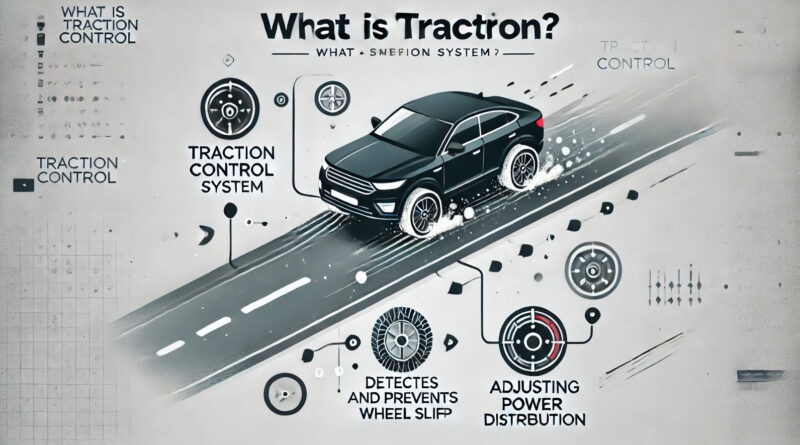What Is Traction Control and Why Does It Matter?
Ever tried accelerating on a wet or icy road, only to feel your tires spin helplessly? That’s where traction control comes in—a simple but essential safety feature that helps keep your car stable when roads get slippery.
Whether you’ve seen the traction control light flash on your dashboard or just want to understand how it works, this guide will break it down in a way that actually makes sense.
What Exactly Is Traction Control?
In simple terms, traction stops your wheels from spinning out of control when you accelerate on a slippery surface.
It’s a built-in system that constantly monitors your tires. If it senses that one or more wheels are losing grip, it automatically reduces engine power or applies brakes to regain traction.
Why Is Traction Control Important?
✔️ Helps prevent wheel spin on slippery roads
✔️ Keeps your car stable when accelerating
✔️ Reduces the chances of skidding or losing control
✔️ Works with your anti-lock braking system (ABS) and stability control
Basically, traction gives you better control over your car in situations where grip is limited.
How Does Traction Control Work?
Your car’s traction control system is always watching your wheels, thanks to wheel speed sensors. Here’s what happens when you hit a slippery patch:
1️⃣ Sensors detect a wheel losing grip – Maybe you’re on an icy road, a wet highway, or even loose gravel.
2️⃣ The system kicks in – If it notices that one wheel is spinning faster than the others, it steps in to fix the problem.
3️⃣ It reduces power or applies brakes – The system will either:
- Cut engine power to slow down the slipping wheel.
- Apply the brakes to regain traction.
4️⃣ You keep moving forward—safely – Once your tires regain grip, traction backs off, and you continue driving normally.
Think of it like an automatic helping hand that keeps your car from sliding when the road gets tricky.
When Does Traction Control Activate?
You’ll most likely notice traction in action when:
🚗 Driving on wet or icy roads – Prevents wheel spin when starting or accelerating.
🛣️ Going uphill on a steep road – Stops the wheels from slipping while trying to gain speed.
🏎️ Turning corners quickly – Keeps the car stable so it doesn’t slide.
Whenever traction is working, you might see a flashing light on your dashboard—this means it’s helping you maintain grip.
Can You Turn Off Traction Control?
Yes! Most cars allow you to switch off traction, but should you? That depends on the situation.
When You Should Turn It OFF
🚙 If You’re Stuck in Snow, Sand, or Mud – Sometimes, a little wheel spin helps you rock the car back and forth to get unstuck.
🏁 For Performance Driving – If you’re on a racetrack, turning off traction control allows you to have more control over throttle and cornering.
🛻 Off-Road Driving – When tackling rocky terrain or loose gravel, controlled wheel spin can actually help you keep momentum.
When You Should Leave It ON
✔️ Everyday driving (especially in rain or snow)
✔️ When driving at high speeds (traction helps prevent unexpected skids)
✔️ During heavy traffic or highway driving (stability is key)
For most drivers, it’s best to leave traction on, unless you know exactly when and why to turn it off.
Traction Control vs. Stability Control: What’s the Difference?
People often confuse traction control (TC) and stability control (ESC). They work together but serve different purposes:
| Feature | Traction Control (TC) | Stability Control (ESC) |
|---|---|---|
| Purpose | Stops wheels from spinning | Prevents the car from sliding/skidding |
| How It Works | Adjusts engine power & applies brakes to slipping wheels | Helps keep the car balanced during sharp turns or sudden maneuvers |
| Best For | Acceleration on slippery roads | Handling & cornering at high speeds |
Think of it like this:
- Traction control keeps your wheels from spinning.
- Stability control keeps your car from losing control.
Both work together to keep your drive safe and smooth.
Common Traction Control Problems & Fixes
Even though TC is reliable, it can sometimes have issues. Here’s what to watch out for:
🚨 Light Stays On
- Could mean a sensor is dirty, damaged, or malfunctioning.
🚨 Doesn’t Activate When Needed
- If your wheels are slipping and the system isn’t working, you may need diagnostic testing.
🚨 Loss of Power or Acceleration Feels Weak
- Sometimes, TC cuts power unnecessarily, making it hard to accelerate.
How to Fix It:
✅ Try restarting the car – Sometimes, a simple reset fixes minor issues.
✅ Check the wheel speed sensors – Dirt or damage can cause false readings.
✅ Use an OBD-II scanner – A quick scan can reveal error codes related to the system.
✅ Visit a mechanic – If the issue persists, get it checked by a pro.
Final Thoughts: Do You Really Need Traction Control?
Yes! Traction is one of the best safety features in modern cars. It helps prevent skids, improves stability, and makes driving in bad weather safer.
🚗 Leave it ON for daily driving.
❄️ Turn it OFF if you’re stuck in deep snow, sand, or mud.
⚙️ If the traction light stays on, get it checked.
At the end of the day, traction is there to help, but it doesn’t replace good driving habits.
💡 Drive cautiously in bad weather, use the right tires, and always stay aware of road conditions—because the best traction system is still a careful driver!

